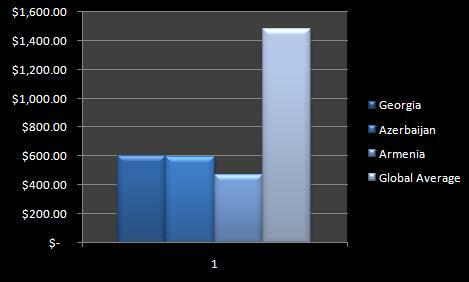
Average monthly wage in Armenia is more than 3 times less than the global average, which is estimated to be equal to $1,480 a month according to the study published last year by the United Nations’ International Labour Organization (ILO). Furthermore, the average wage in Armenia is the lowest among the three Caucasian states.
The global average wage is a figure based on data from 72 countries. Some of the world’s poorest countries, as well as countries for which reliable data is not available, are omitted from the study.
Additionally, the figures are in adjusted exchange rates – the average salary is calculated in Purchasing Power Parity (PPP) dollars. Given the adjustments, the average wage in Armenia is estimated to be equal to $471 US.
Georgians ($603) and Azerbaijanis ($596) are slightly better off, but the Caucasus as a whole is seriously lagging behind most of the 72 countries included in the study.
It is rather depressing to understand that the people of the resource-rich Caucasus region, which is so conveniently placed on international trade routes and is rich on human capital, are losing so much to conflicts buried in their common tragic histories.
Meanwhile, here’s a table showing the rank of average monthly salary or wage in the world for some of the countries included in the study.
I’ve included the top 10 earning countries, as well as regional superpowers — Russia and Turkey — the Caucasus and the worst 3 countries.
Check this link for the complete list. Also, BBC website has great infographic, which let’s you input your salary and see if you’re earning more or less than the world’s average wage.
| Rank | Country | Average Wage (USD) |
|---|---|---|
| 1 | Luxembourg | 4,089 |
| 2 | Norway | 3,678 |
| 3 | Austria | 3,437 |
| 4 | United States | 3,263 |
| 5 | United Kingdom | 3,065 |
| 6 | Belgium | 3,035 |
| 7 | Sweden | 3,023 |
| 8 | Ireland | 2,997 |
| 9 | Finland | 2,925 |
| 10 | Korea (Republic of) | 2,903 |
| 28 | Turkey | 1,731 |
| 37 | Russian Federation | 1,215 |
| 59 | Georgia | 603 |
| 60 | Azerbaijan | 596 |
| 63 | Armenia | 471 |
| 70 | Philippines | 279 |
| 71 | Pakistan | 255 |
| 72 | Tajikistan | 227 |
And it also should be mentioned that prices in Armenia are not the lowest in the region. In any other country this combination, sour truth (high prices and low wage) would result into public unrest. But not in Armenia.
Another tradegy is, only one out of 8 candidates for presidency offers a plan on how to overcome this crisis. This is not a joke.
You mean only Hrant Bagratian offers a solution, right?
Exactly, at least the guy honestly says what his program is. Tries to tell what, when and how he is going to change.
Well, you have to look at the purchasing power parity, i.e. is $1 of the same value in Armenia than, say, the US. For example, The Economist uses “Big Mac” parity to measure this but there are no Big Macs in Armenia yet. One could use the cost of the consumer basket but the contents are not identical among countries.
In any case, food, electronics, durable goods and energy seem to be more expensive in Armenia than the US while real estate is cheaper, and vastly cheaper in places outside Yerevan.
Shoot, should have paid more attention to the contents, I skipped the part about the PPP adjustment.
🙂
PP adjustment?
PS: Services are extremely cheap in Armenia as well. A regular bus costs the average person over $3 each way in Toronto and taking the more comfortable busses costs about 6-9$ each way. Forget taking taxis as they cost around $30-$80 within the city and you are looking at $100+ going outside of the Greater Toronto area, still within a half hour of the city. Getting a haircut is at least $35, usually around $50. Junk food may be cheaper, but healthy living costs about $150-$300 a week, not eating out. The ratio there definitely needs to be more equal, but people face inflation and a disparity between the amount earned and amount forced to spend per month everywhere. Rent alone is at least $600 a month here in the suburbs. If you want downtown, $1000 on rent alone without utilities easily. Not saying the people can’t afford it normally, but most just get by and the poverty rate is 9% overall in the country. In 2006, it was nearly 16% so the drop has been great! but it still exists and people in the middle of Downtown Toronto even can barely afford food and new clothing, living in government housing. I may not know about other countries, but I know what my city looks like at least 😀
http://www.thestar.com/news/gta/2012/06/11/nearly_a_quarter_of_toronto_residents_live_in_poverty_james.html